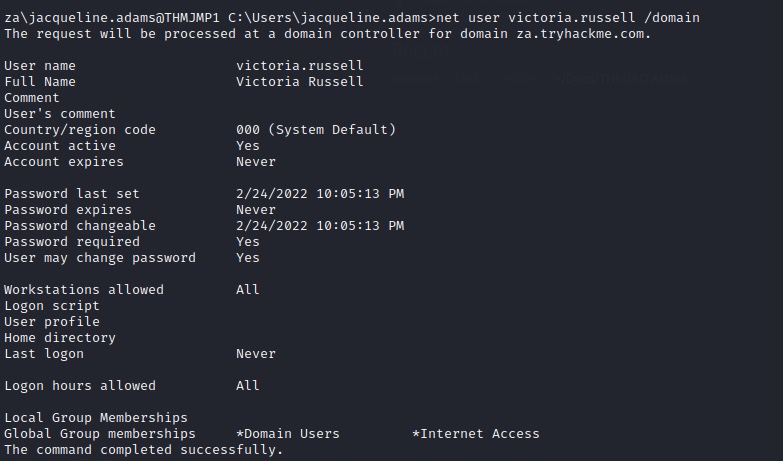Enumerating Active Directory
[TOC]
The Attack Life Cycle
- Reconnaissance
- Initial Exploitation
- Establish Foothold
- Escalate Privileges
- Internal Reconnaissance
- Lateral Movement
- Maintain Presence
- Complete Mission
Task 1 Why AD Enumeration
Configure the DNS for za.tryhackme.com ,
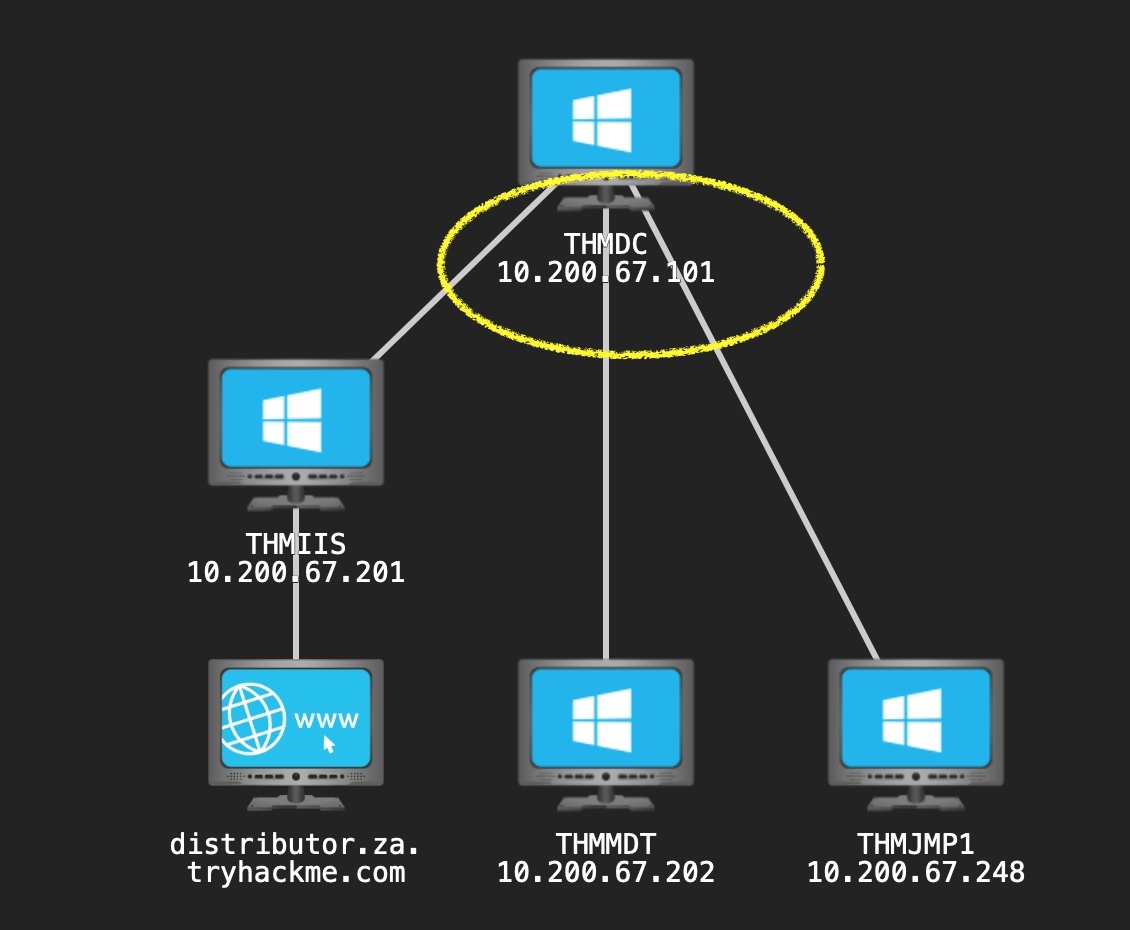
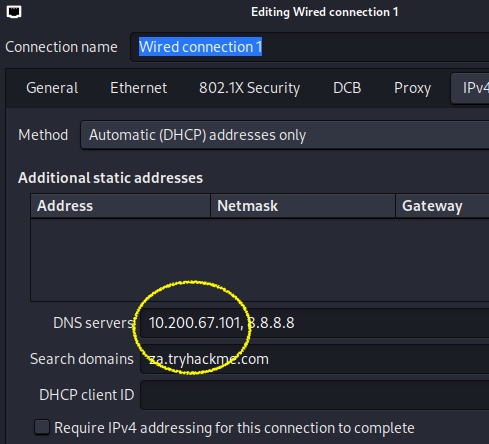
restart the network connection
$ sudo systemctl restart NetworkManager
Check that network connection has been configured correctly .
$ nslookup thmdc.za.tryhackme.com

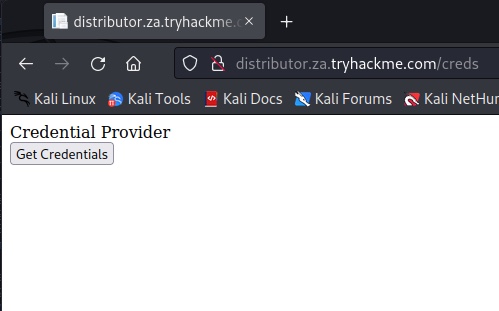
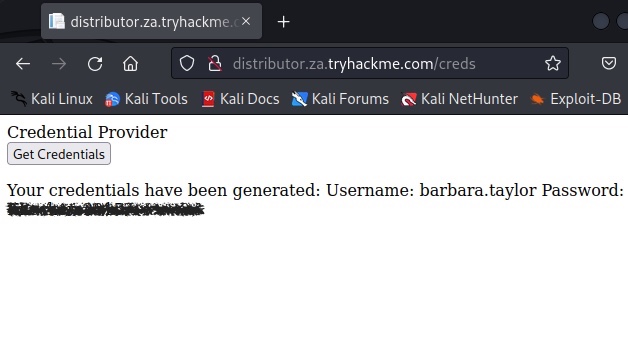
Using SSH
kali@kali:~$ ssh za.tryhackme.com\\jacqueline.adams@thmjmp1.za.tryhackme.com
za.tryhackme.com\jacqueline.adams@thmjmp1.za.tryhackme.com's password:
Using RDP
$ xfreerdp /d:za.tryhackme.com /u:jacqueline.adams /p:Gaiw6681 /v:thmjmp1.za.tryhackme.com /drive:. +clipboard
Task 2 Credential Injection
Let’s RDP thmjmp1
$ xfreerdp /d:za.tryhackme.com /u:mandy.bryan /p:Dbrnjhbz1986 /v:thmjmp1.za.tryhackme.com /drive:. +clipboard /size:1024x640
Obtain different credential

runas.exe /netonly /user:za.tryhackme.com\kimberley.smith cmd.exe
c:\runas.exe /netonly /user:za.tryhackme.com\kimberley.smith cmd.exe
Configuring DNS in windows machine (just for illustration as it requires permissions), the DNS was already configured
$dnsip = "<DC IP>"
$index = Get-NetAdapter -Name 'Ethernet' | Select-Object -ExpandProperty 'ifIndex'
Set-DnsClientServerAddress -InterfaceIndex $index -ServerAddresses $dnsip
Is there a difference between
dir \\za.tryhackme.com\SYSVOLanddir \\<DC IP>\SYSVOLWhen we provide the hostname, network authentication will attempt first to perform Kerberos authentication. Since Kerberos authentication uses hostnames embedded in the tickets, if we provide the IP instead, we can force the authentication type to be NTLM
Task 2 Answers
What native Windows binary allows us to inject credentials legitimately into memory?
runas.exeWhat parameter option of the runas binary will ensure that the injected credentials are used for all network connections?
/netonlyWhat network folder on a domain controller is accessible by any authenticated AD account and stores GPO information?
SYSVOLWhen performing dir \\za.tryhackme.com\SYSVOL, what type of authentication is performed by default?
Kerberos AuthenticationTask 3 Enumeration through Microsoft Management Console
$ xfreerdp /d:za.tryhackme.com /u:damien.horton /p:pABqHYKsG8L7 /v:thmjmp1.za.tryhackme.com /drive:. +clipboard
##
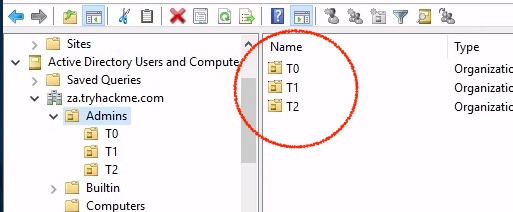 | 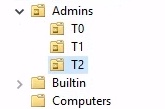 |
|---|---|
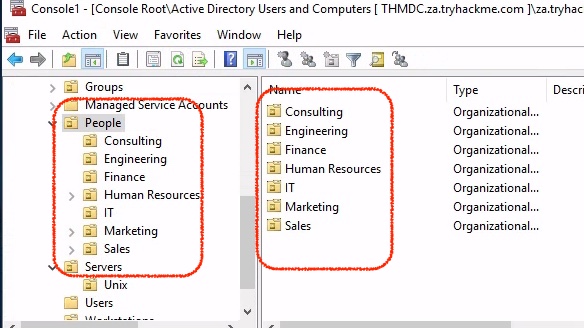 | 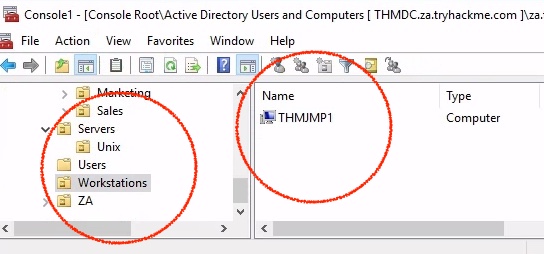 |
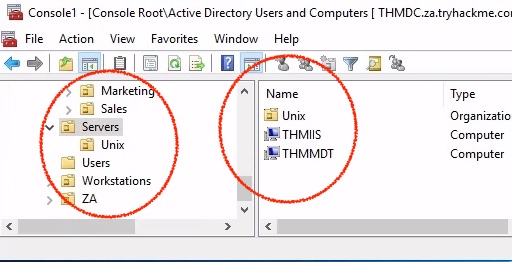 | 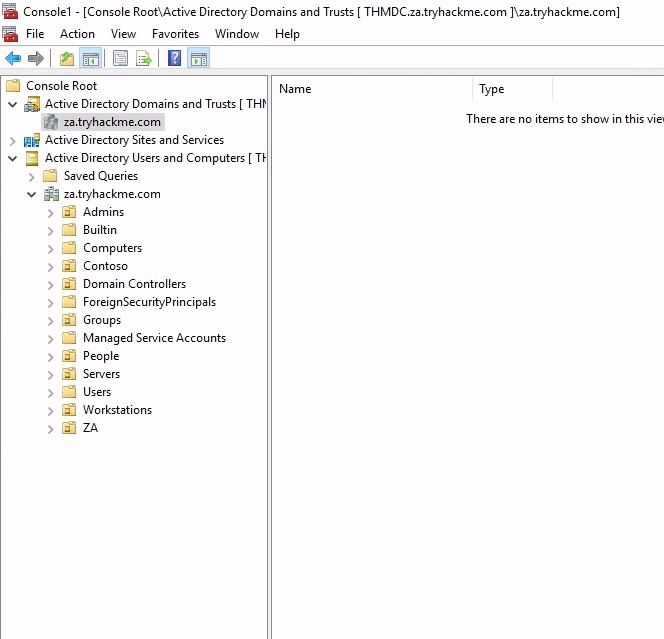 |
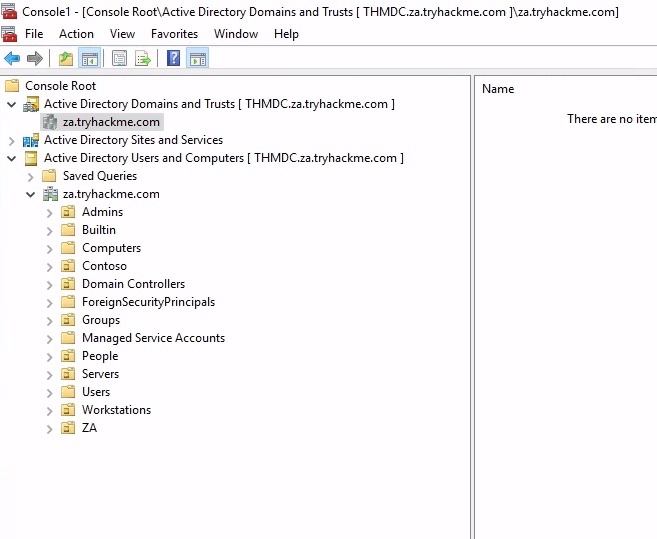 |
Task 3 Answers
How many Computer objects are part of the Servers OU?
2How many Computer objects are part of the Workstations OU?
1How many departments (Organisational Units) does this organisation consist of?
7How many Admin tiers does this organisation have?
3What is the value of the flag stored in the description attribute of the t0_tinus.green account?
THM{Enumerating.Via.MMC}the credentials will not be verified directly by a domain controller so that it will accept any password. We still need to confirm that the network credentials are loaded successfully and correctly.
Task 4 Enumeration through Command Prompt
Enumerating Users
use the net command to list all the users in the AD domain by using the user option
C:\Users\jacqueline.adams>net user /domain
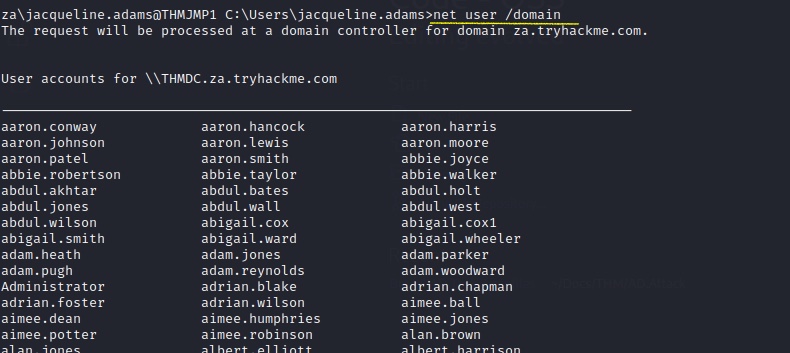
Let’s enumerate more detals about specific users
C:\Users\jacqueline.adams>net user victoria.russell /domain
Enumerting the user guest as well

Enumerating Groups
Use the net command to enumerate groups by adding group option:
C:\Users\jacqueline.adams>net group /domain
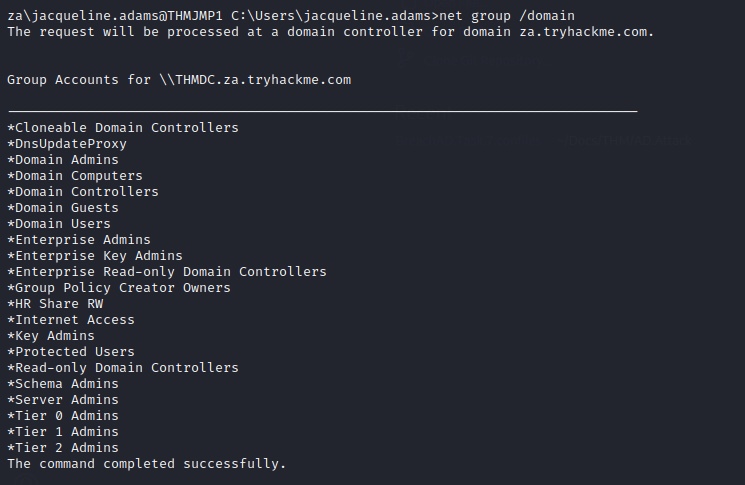
Enumerate more details about members in the group “Tier 1 Admins”
C:\Users\jacqueline.adams>net group "Tier 1 Admins" /domain

Password Policy
C:\Users\jacqueline.adams>net accounts /domain

Task 4 Answers
Apart from the Domain Users group, what other group is the aaron.harris account a member of?
Internet AccessIs the Guest account active? (Yay,Nay)
NayHow many accounts are a member of the Tier 1 Admins group?
7What is the account lockout duration of the current password policy in minutes?
30Task 5 Enumeration through PowerShell
Switch command line to powershell
c:\ > Powershell -executionpolicy bypass
Enumerate Users
Get-ADUser
using the Get-ADUser cmdlet to enumerate user with the below options
- -Identity - The account name that we are enumerating
- -Properties - Which properties associated with the account will be shown, * will show all properties
- -Server - Since we are not domain-joined, we have to use this parameter to point it to our domain controller
PS C:\Users\jacqueline.adams> Get-ADUser -Identity gordon.stevens -Server za.tryhackme.com -Properties *
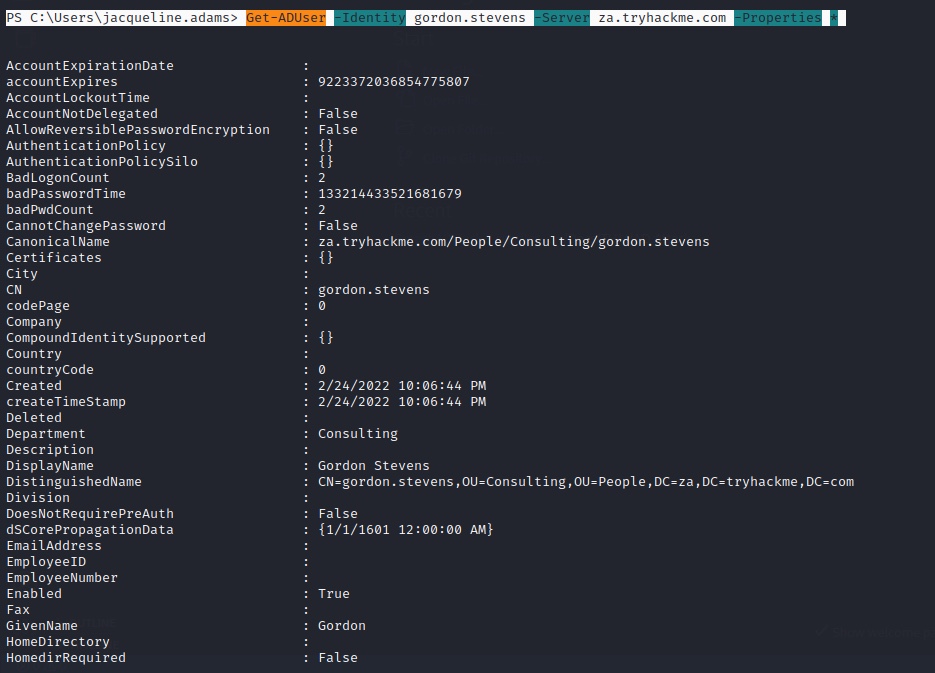
Get-ADUser filter
PS C:\> Get-ADUser -Filter 'Name -like "*stevens"' -Server za.tryhackme.com | Format-Table Name,SamAccountName -A

get the Title attribute of Beth Nolan (beth.nolan)
PS C:\Users\jacqueline.adams> Get-ADUser -Identity beth.nolan -Server za.tryhackme.com -Properties * | Format-Table Name,Title -A

Get the DistinguishedName name for user annette.manning
PS C:\Users\jacqueline.adams> Get-ADUser -Identity annette.manning -Properties DistinguishedName

Enumerating Groups
Get-ADGroup
Enumerate groups using Get-ADGroup cmdlet
PS C:\> Get-ADGroup -Identity Administrators -Server za.tryhackme.com

Get the creation date/time of the Tier 2 Admins group
PS C:\Users\jacqueline.adams> Get-ADGroup -Filter 'Name -like "Tier 2 Admins"' -Server za.tryhackme.com -Properties Created
-------------------------------------------
Created : 2/24/2022 10:04:41 PM
Get the Value of SID attribute of the Enterprise Admins group
PS C:\Users\jacqueline.adams> Get-ADGroup -Filter 'Name -like "Enterprise Admins"' -Server za.tryhackme.com -Properties * | Format-Table Name,SID -A
Name SID
---- ---
Enterprise Admins S-1-5-21-3330634377-1326264276-632209373-519
Get-ADGroupMember
Enumerate groups using Get-ADGroupMember cmdlet
PS C:\> Get-ADGroupMember -Identity Administrators -Server za.tryhackme.com
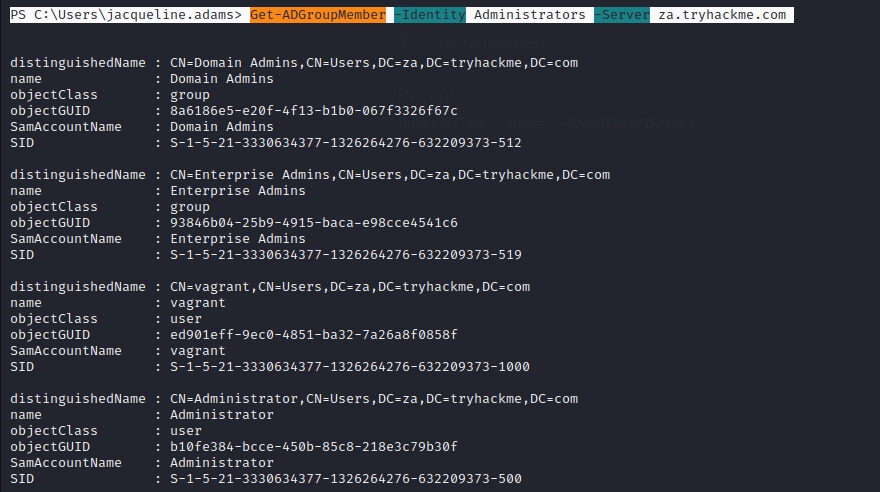
AD Objects
AD Objects used as generic search for any AD Object, get AD objects were changed after a specific date
PS C:\> $ChangeDate = New-Object DateTime(2022, 02, 28, 12, 00, 00)
PS C:\> Get-ADObject -Filter 'whenChanged -gt $ChangeDate' -includeDeletedObjects -Server za.tryhackme.com
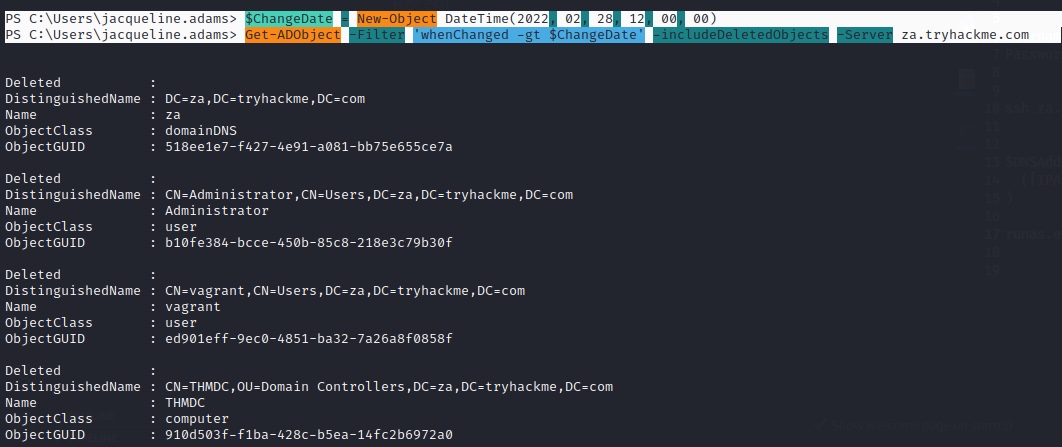
Enumerate accounts to show users in the network who mistyped their password
PS C:\> Get-ADObject -Filter 'badPwdCount -gt 0' -Server za.tryhackme.com
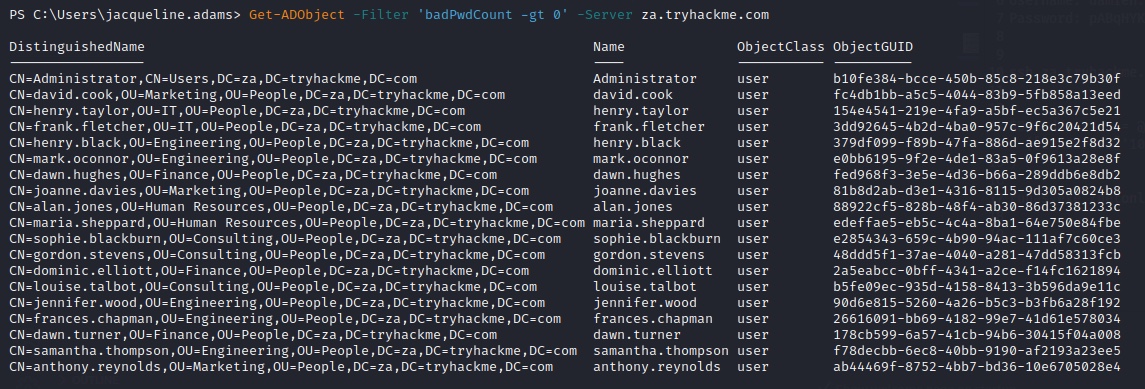
Domains
Get-ADDomain
PS C:\> Get-ADDomain -Server za.tryhackme.com
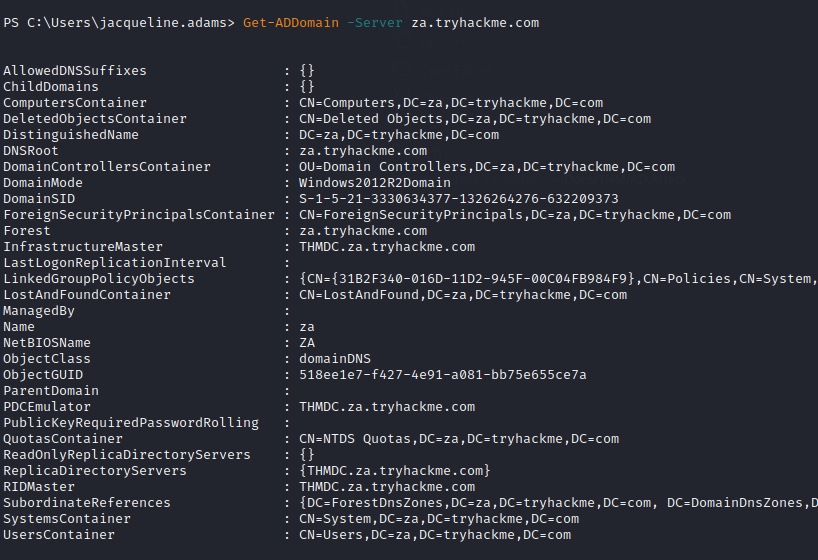
Changing user password
PS C:\Users\jacqueline.adams> Set-ADAccountPassword -Identity leon.jennings -Server za.tryhackme.com -OldPassword (ConvertTo-SecureString -AsPlaintext "Password!" -force) -NewPassword (ConvertTo-S
ecureString -AsPlainText "Password!new" -Force)
PS C:\Users\jacqueline.adams>
Task 5 Answers
What is the value of the Title attribute of Beth Nolan (beth.nolan)?
SeniorWhat is the value of the DistinguishedName attribute of Annette Manning (annette.manning)?
CN=annette.manning,OU=Marketing,OU=People,DC=za,DC=tryhackme,DC=comWhen was the Tier 2 Admins group created?
2/24/2022 10:04:41 PMWhat is the value of the SID attribute of the Enterprise Admins group?
S-1-5-21-3330634377-1326264276-632209373-519Which container is used to store deleted AD objects?
CN=Deleted Objects,DC=za,DC=tryhackme,DC=comTask 6 Enumeration through Bloodhound
Bloodhound allowed attackers (and by now defenders too) to visualise the AD environment in a graph format with interconnected nodes. Each connection is a possible path that could be exploited to reach a goal. In contrast, the defenders used lists, like a list of Domain Admins or a list of all the hosts in the environment…. (TryHackMe)
We will use Sharphound first to enumerate AD before we can look at the results visually using Bloodhound.
Download the BloodHound zip file
$ scp jacqueline.adams@THMJMP1.za.tryhackme.com:C:/tools/121,298 20230301155305_BloodHound.zip .
Run ne4j
kali@kali:/etc/neo4j$ sudo neo4j console
Upload the Bloodhound zip file
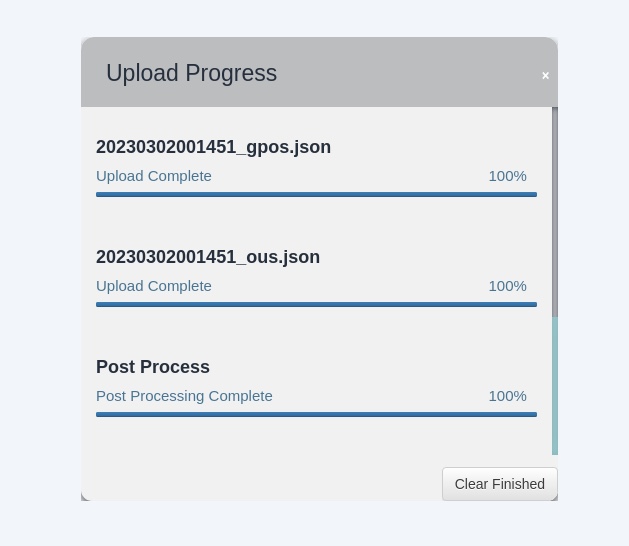
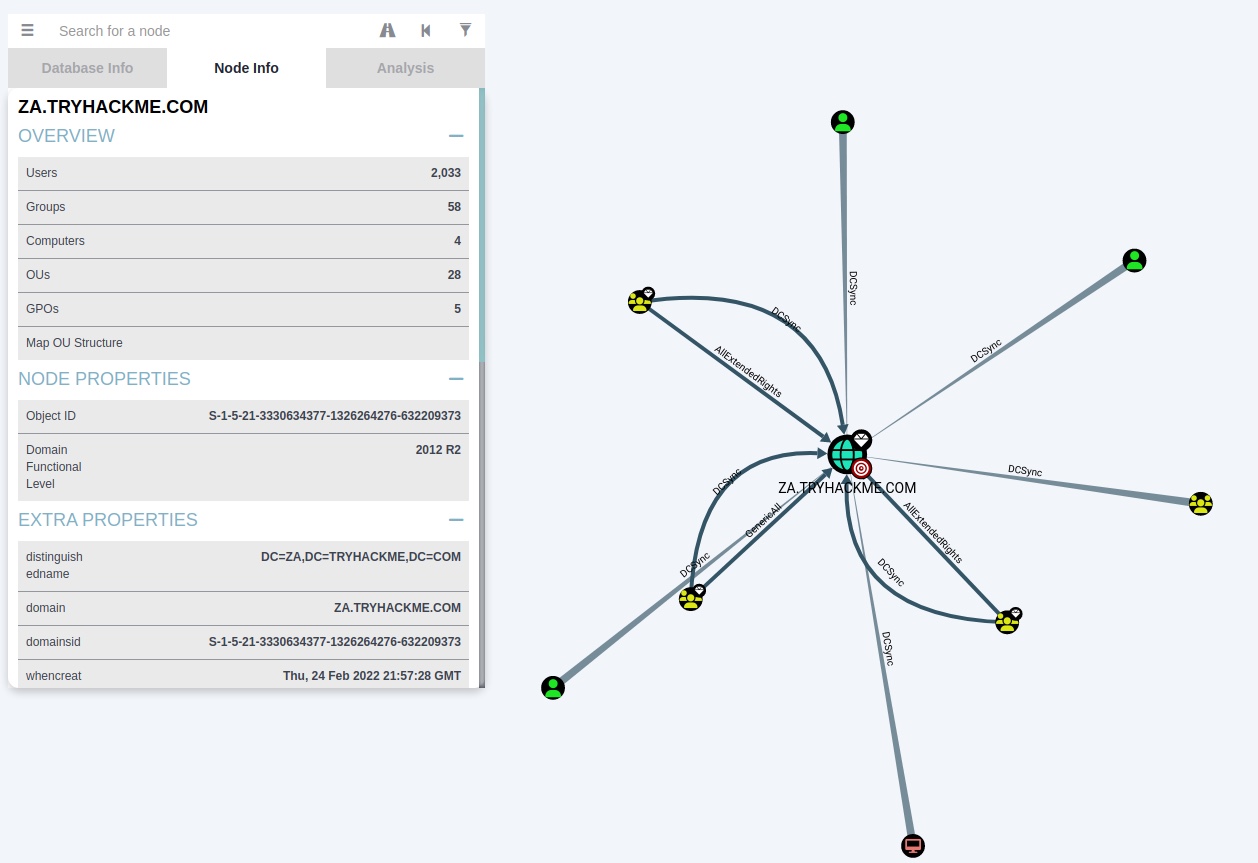
Pre-Built Analytics Queries
Domain Information
Find all domain admins
MATCH p=(n:Group)<-[:MemberOf*1..]-(m) WHERE n.objectid =~ "(?i)S-1-5-.*-512" RETURN p
Map domain trusts
MATCH p=(n:Domain)-->(m:Domain) RETURN p
Find Computers with Unsupported Operating Systems
MATCH (n:Computer) WHERE n.operatingsystem =~ "(?i).*(2000|2003|2008|xp|vista|7|me).*" RETURN n
Dangerous Privileges
Find Principals with DCSync Rights
MATCH p=()-[:DCSync|AllExtendedRights|GenericAll]->(:Domain {name: "ZA.TRYHACKME.COM"}) RETURN p
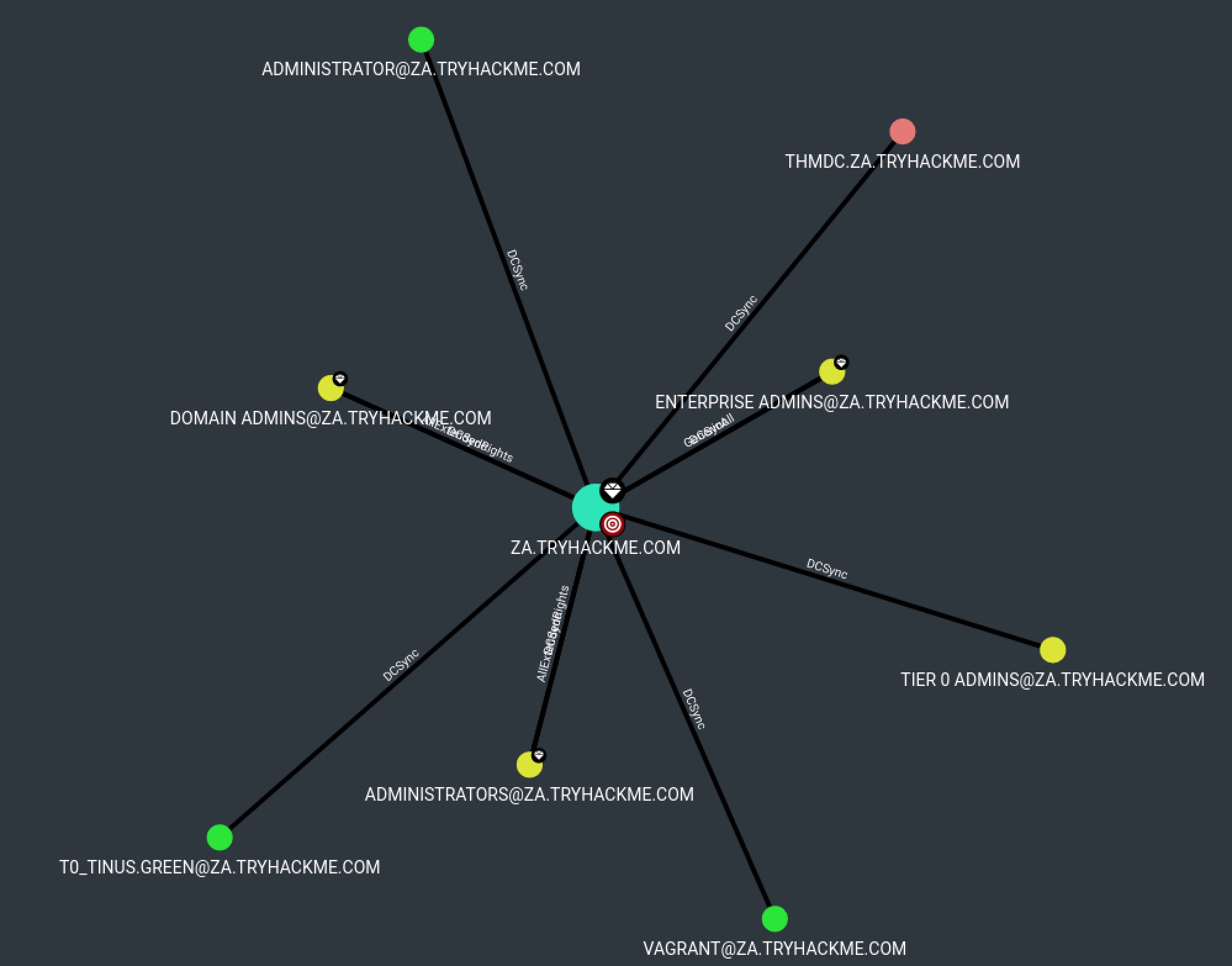
Users with Foreign Domain Group Membership
MATCH p=(n:User)-[:MemberOf]->(m:Group) WHERE n.domain="ZA.TRYHACKME.COM" AND m.domain<>n.domain RETURN p
Find Computers where Domain Users are Local Admin
MATCH p=(m:Group {name:"DOMAIN USERS@ZA.TRYHACKME.COM"})-[:AdminTo]->(n:Computer) RETURN p
Find Computers where Domain Users can read LAPS passwords
MATCH p=(Group {name:"DOMAIN USERS@ZA.TRYHACKME.COM"})-[:MemberOf*0..]->(g:Group)-[:AllExtendedRights|ReadLAPSPassword]->(n:Computer) RETURN p
Find All Paths from Domain Users to High Value Targets
MATCH p=shortestPath((g:Group {name:"DOMAIN USERS@ZA.TRYHACKME.COM"})-[*1..]->(n {highvalue:true})) WHERE g<>n return p
Find Workstations where Domain Users can RDP
match p=(g:Group {name:"DOMAIN USERS@ZA.TRYHACKME.COM"})-[:CanRDP]->(c:Computer) where NOT c.operatingsystem CONTAINS "Server" return p
Find Servers where Domain Users can RDP
MATCH p=(g:Group {name:"DOMAIN USERS@ZA.TRYHACKME.COM"})-[:CanRDP]->(c:Computer) WHERE c.operatingsystem CONTAINS "Server" return p
Find Dangerous Privileges for Domain Users Groups
MATCH p=(m:Group)-[:Owns|WriteDacl|GenericAll|WriteOwner|ExecuteDCOM|GenericWrite|AllowedToDelegate|ForceChangePassword]->(n:Computer) WHERE m.objectid ENDS WITH "-513" RETURN p
Find Domain Admin Logons to non-Domain Controllers
MATCH (dc)-[r:MemberOf*0..]->(g:Group) WHERE g.objectid ENDS WITH '-516' WITH COLLECT(dc) AS exclude MATCH p = (c:Computer)-[n:HasSession]->(u:User)-[r2:MemberOf*1..]->(g:Group) WHERE g.objectid ENDS WITH '-512' AND NOT c IN exclude RETURN p
Kerberos Interaction
Find Kerberoastable Members of High Value Groups
MATCH p=shortestPath((n:User)-[:MemberOf]->(g:Group)) WHERE g.highvalue=true AND n.hasspn=true RETURN p
List all Kerberoastable Accounts
MATCH (n:User)WHERE n.hasspn=true RETURN n
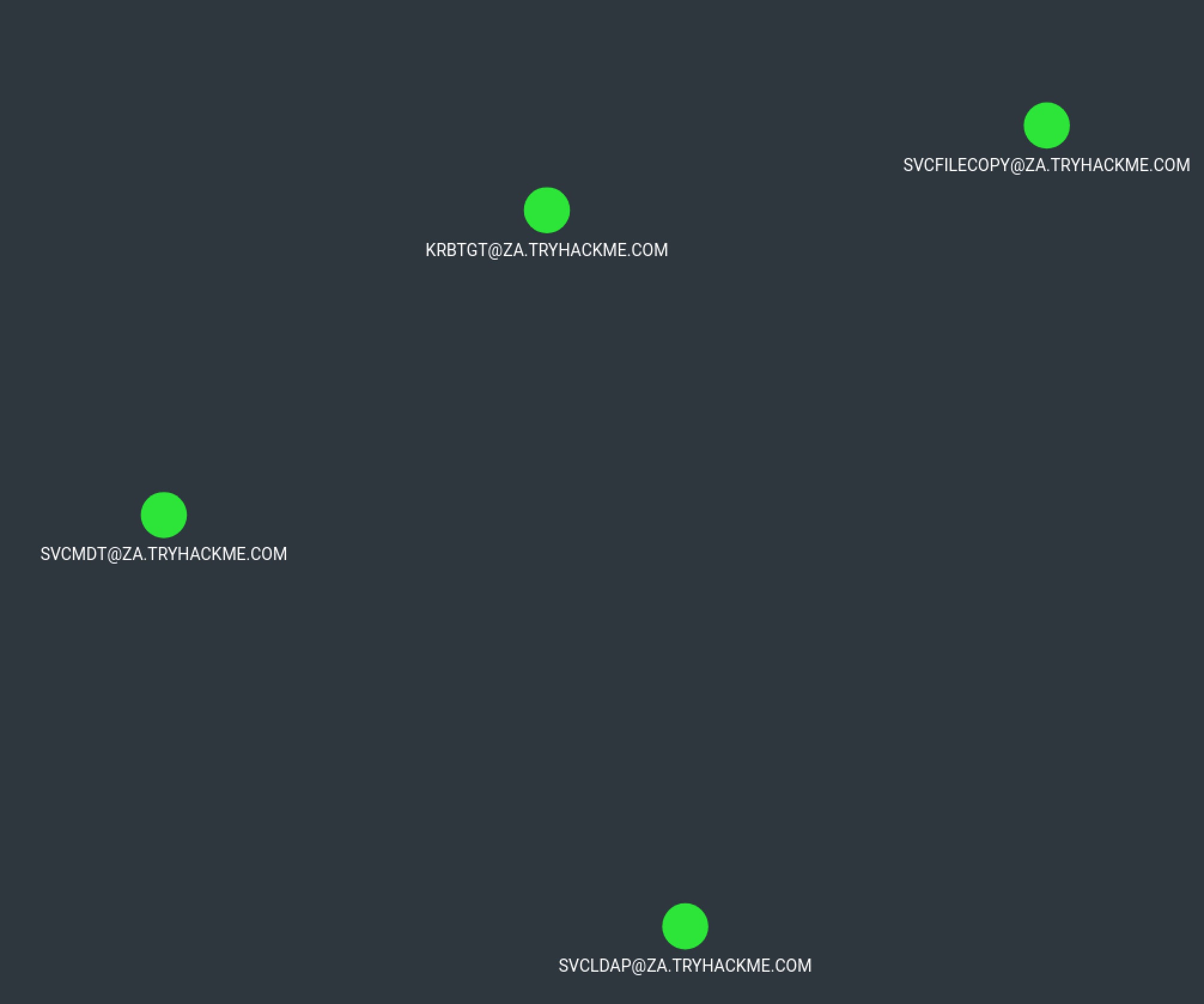
Find Kerberoastable Users with most privileges
MATCH (u:User {hasspn:true}) OPTIONAL MATCH (u)-[:AdminTo]->(c1:Computer) OPTIONAL MATCH (u)-[:MemberOf*1..]->(:Group)-[:AdminTo]->(c2:Computer) WITH u,COLLECT(c1) + COLLECT(c2) AS tempVar UNWIND tempVar AS comps RETURN u.name,COUNT(DISTINCT(comps)) ORDER BY COUNT(DISTINCT(comps)) DESC
Find AS-REP Roastable Users (DontReqPreAuth)
MATCH (u:User {dontreqpreauth: true}) RETURN u
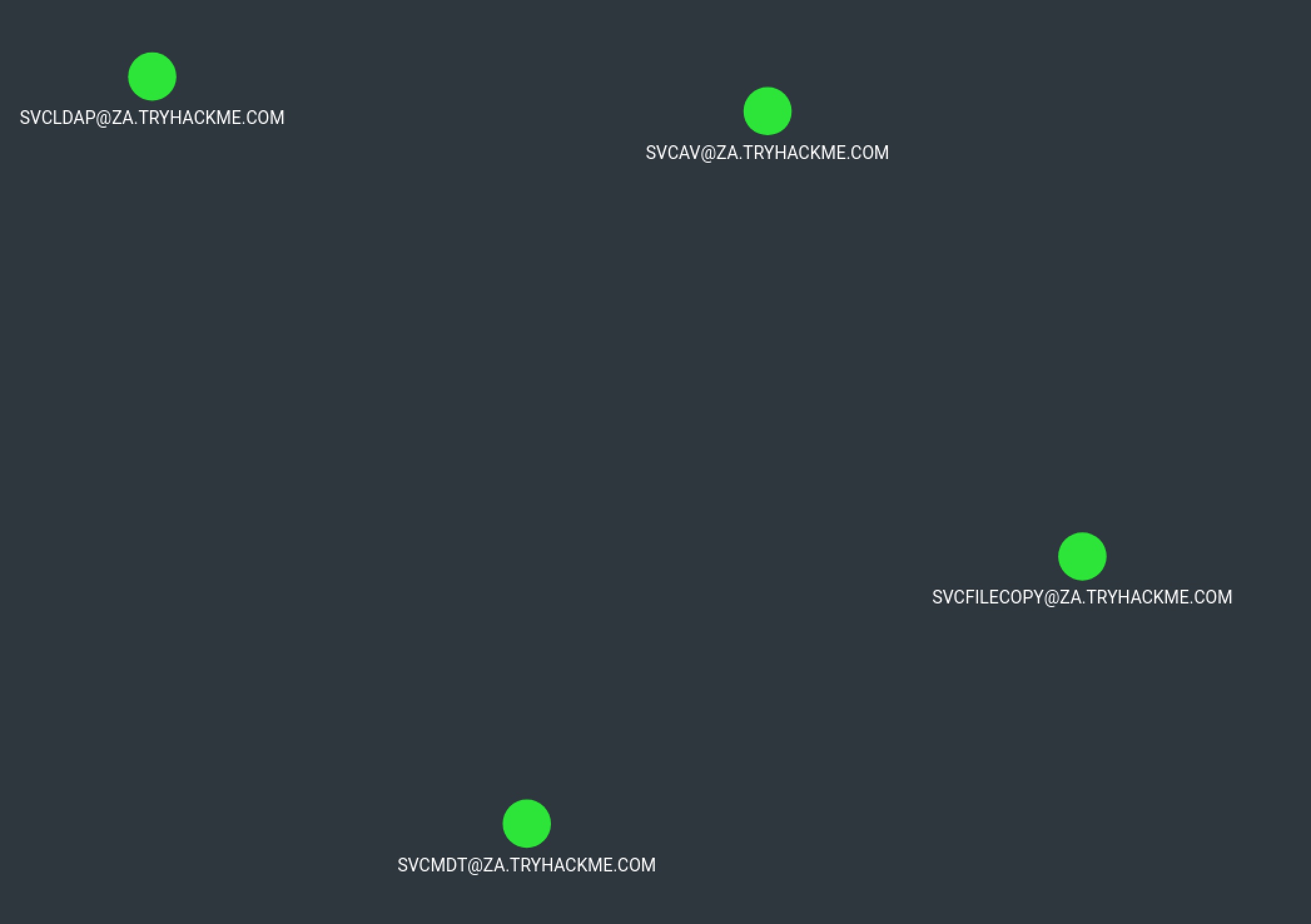
Shortest Paths
Shortest Paths to Unconstrained Delegation Systems
MATCH (n) MATCH p=shortestPath((n)-[:MemberOf|HasSession|AdminTo|AllExtendedRights|AddMember|ForceChangePassword|GenericAll|GenericWrite|Owns|WriteDacl|WriteOwner|CanRDP|ExecuteDCOM|AllowedToDelegate|ReadLAPSPassword|Contains|GPLink|AddAllowedToAct|AllowedToAct|SQLAdmin|ReadGMSAPassword|HasSIDHistory|CanPSRemote|SyncLAPSPassword|AZAddMembers|AZAddSecret|AZAvereContributor|AZContains|AZContributor|AZExecuteCommand|AZGetCertificates|AZGetKeys|AZGetSecrets|AZGlobalAdmin|AZGrant|AZGrantSelf|AZHasRole|AZMemberOf|AZOwner|AZOwns|AZPrivilegedRoleAdmin|AZResetPassword|AZUserAccessAdministrator|AZAppAdmin|AZCloudAppAdmin|AZRunsAs|AZKeyVaultContributor|AZVMAdminLogin|AddSelf|WriteSPN|AddKeyCredentialLink*1..]->(m:Computer {unconstraineddelegation: true})) WHERE NOT n=m RETURN p
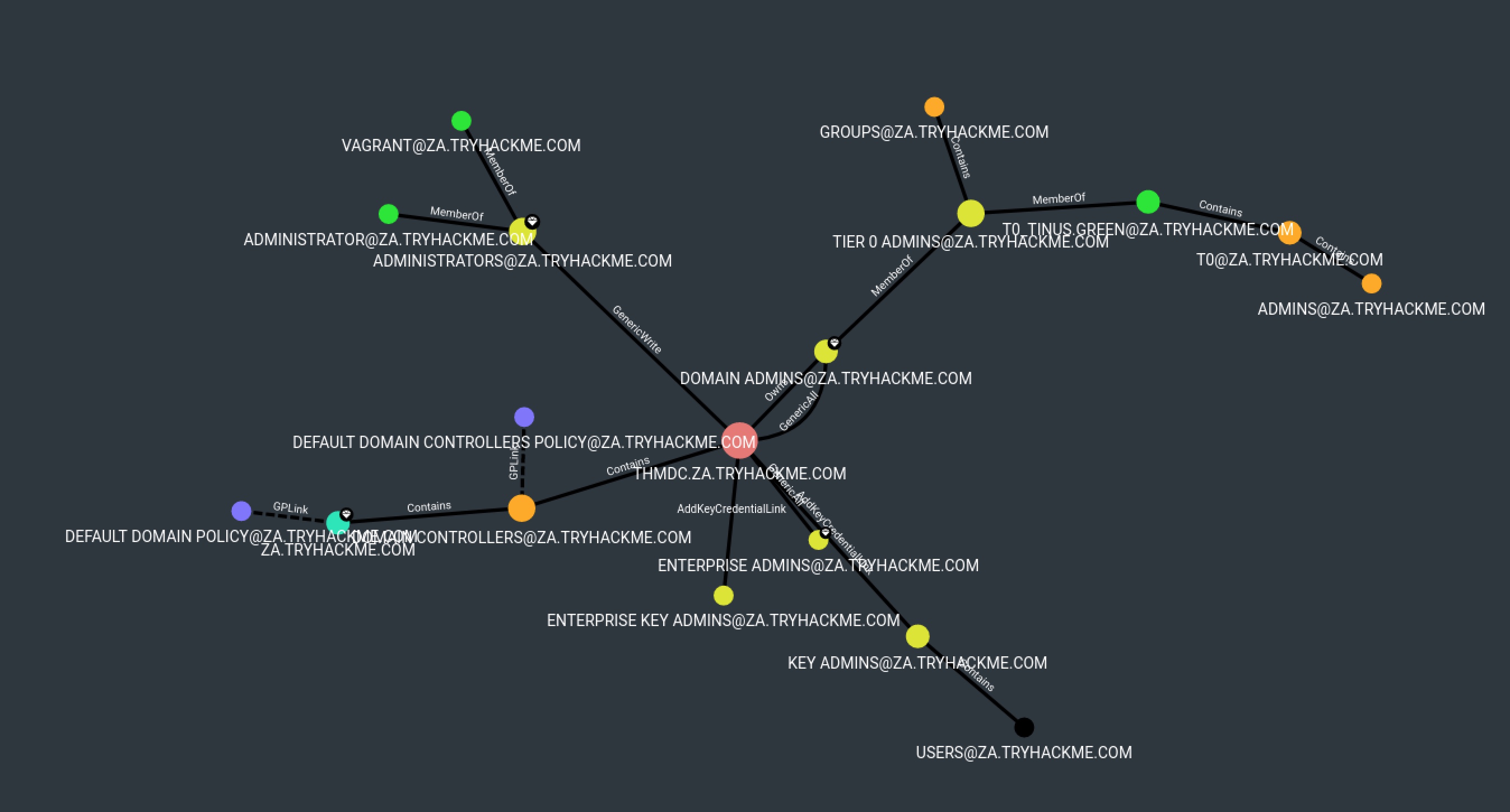
Shortest Paths from Kerberoastable Users
MATCH p=shortestPath((a:User {name:"SVCFILECOPY@ZA.TRYHACKME.COM"})-[:MemberOf|HasSession|AdminTo|AllExtendedRights|AddMember|ForceChangePassword|GenericAll|GenericWrite|Owns|WriteDacl|WriteOwner|CanRDP|ExecuteDCOM|AllowedToDelegate|ReadLAPSPassword|Contains|GPLink|AddAllowedToAct|AllowedToAct|SQLAdmin|ReadGMSAPassword|HasSIDHistory|CanPSRemote|SyncLAPSPassword|AZAddMembers|AZAddSecret|AZAvereContributor|AZContains|AZContributor|AZExecuteCommand|AZGetCertificates|AZGetKeys|AZGetSecrets|AZGlobalAdmin|AZGrant|AZGrantSelf|AZHasRole|AZMemberOf|AZOwner|AZOwns|AZPrivilegedRoleAdmin|AZResetPassword|AZUserAccessAdministrator|AZAppAdmin|AZCloudAppAdmin|AZRunsAs|AZKeyVaultContributor|AZVMAdminLogin|AddSelf|WriteSPN|AddKeyCredentialLink*1..]->(b:Computer)) RETURN p
Shortest Paths to Domain Admins from Kerberoastable Users
MATCH p=shortestPath((n:User {hasspn:true})-[:MemberOf|HasSession|AdminTo|AllExtendedRights|AddMember|ForceChangePassword|GenericAll|GenericWrite|Owns|WriteDacl|WriteOwner|CanRDP|ExecuteDCOM|AllowedToDelegate|ReadLAPSPassword|Contains|GPLink|AddAllowedToAct|AllowedToAct|SQLAdmin|ReadGMSAPassword|HasSIDHistory|CanPSRemote|SyncLAPSPassword|AZAddMembers|AZAddSecret|AZAvereContributor|AZContains|AZContributor|AZExecuteCommand|AZGetCertificates|AZGetKeys|AZGetSecrets|AZGlobalAdmin|AZGrant|AZGrantSelf|AZHasRole|AZMemberOf|AZOwner|AZOwns|AZPrivilegedRoleAdmin|AZResetPassword|AZUserAccessAdministrator|AZAppAdmin|AZCloudAppAdmin|AZRunsAs|AZKeyVaultContributor|AZVMAdminLogin|AddSelf|WriteSPN|AddKeyCredentialLink*1..]->(m:Group {name:"DOMAIN ADMINS@ZA.TRYHACKME.COM"})) RETURN p
Shortest Path from Owned Principals
MATCH (n:User)WHERE n.hasspn=true RETURN n
Shortest Paths to Domain Admins from Owned Principals
MATCH p=shortestPath((n {owned:true})-[:MemberOf|HasSession|AdminTo|AllExtendedRights|AddMember|ForceChangePassword|GenericAll|GenericWrite|Owns|WriteDacl|WriteOwner|CanRDP|ExecuteDCOM|AllowedToDelegate|ReadLAPSPassword|Contains|GPLink|AddAllowedToAct|AllowedToAct|SQLAdmin|ReadGMSAPassword|HasSIDHistory|CanPSRemote|SyncLAPSPassword|AZAddMembers|AZAddSecret|AZAvereContributor|AZContains|AZContributor|AZExecuteCommand|AZGetCertificates|AZGetKeys|AZGetSecrets|AZGlobalAdmin|AZGrant|AZGrantSelf|AZHasRole|AZMemberOf|AZOwner|AZOwns|AZPrivilegedRoleAdmin|AZResetPassword|AZUserAccessAdministrator|AZAppAdmin|AZCloudAppAdmin|AZRunsAs|AZKeyVaultContributor|AZVMAdminLogin|AddSelf|WriteSPN|AddKeyCredentialLink*1..]->(m:Group {name:"DOMAIN ADMINS@ZA.TRYHACKME.COM"})) WHERE NOT n=m RETURN p
Shortest Paths to High Value Targets
MATCH p=shortestPath((n)-[*1..]->(m {highvalue:true})) WHERE m.domain="ZA.TRYHACKME.COM" AND m<>n RETURN p
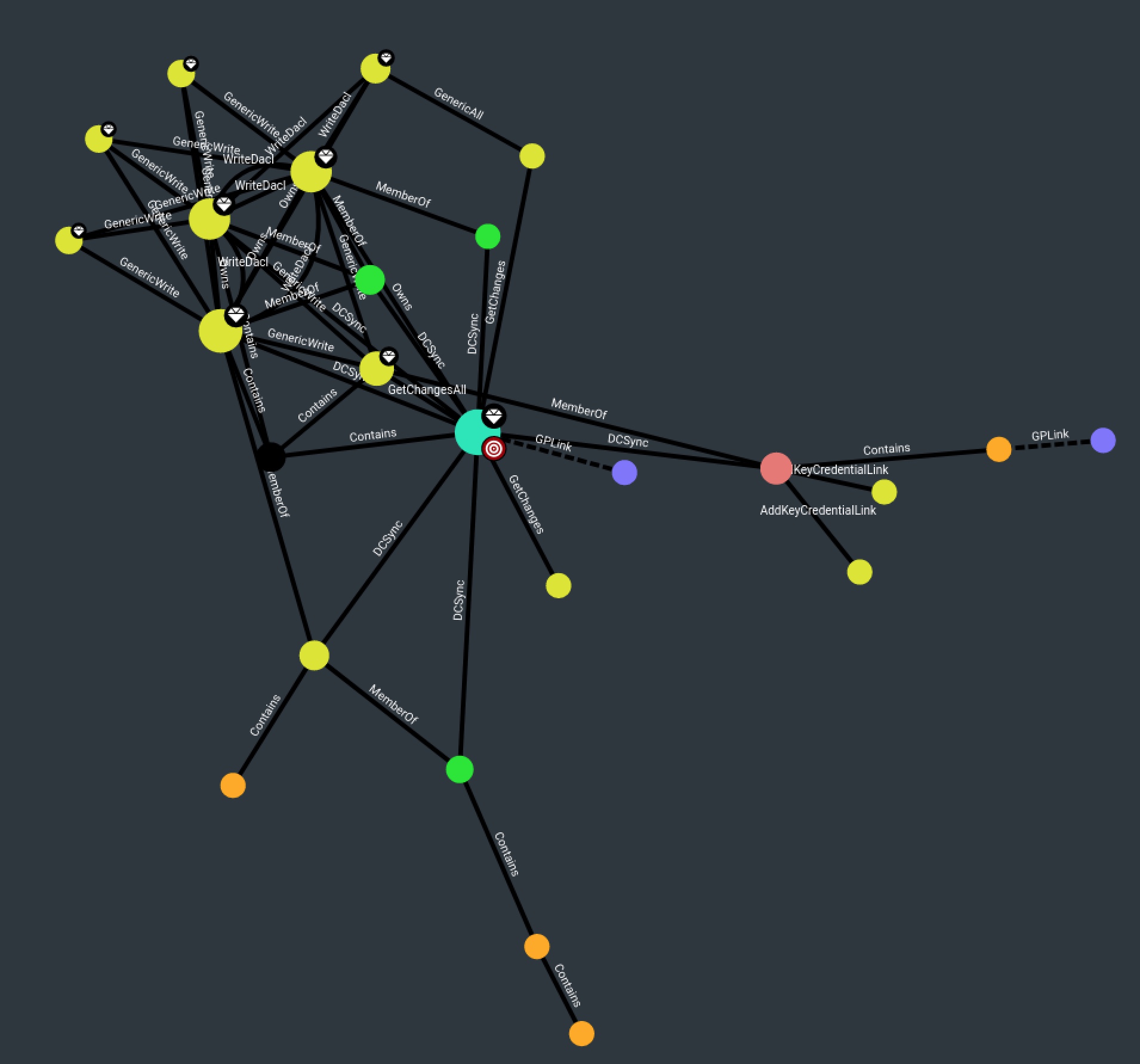
Shortest Paths from Domain Users to High Value Targets
MATCH p=shortestPath((g:Group {name:"DOMAIN USERS@ZA.TRYHACKME.COM"})-[*1..]->(n {highvalue:true})) WHERE g.objectid ENDS WITH "-513" AND g<>n return p
Find Shortest Paths to Domain Admins
MATCH p=shortestPath((n)-[:MemberOf|HasSession|AdminTo|AllExtendedRights|AddMember|ForceChangePassword|GenericAll|GenericWrite|Owns|WriteDacl|WriteOwner|CanRDP|ExecuteDCOM|AllowedToDelegate|ReadLAPSPassword|Contains|GPLink|AddAllowedToAct|AllowedToAct|SQLAdmin|ReadGMSAPassword|HasSIDHistory|CanPSRemote|SyncLAPSPassword|AZAddMembers|AZAddSecret|AZAvereContributor|AZContains|AZContributor|AZExecuteCommand|AZGetCertificates|AZGetKeys|AZGetSecrets|AZGlobalAdmin|AZGrant|AZGrantSelf|AZHasRole|AZMemberOf|AZOwner|AZOwns|AZPrivilegedRoleAdmin|AZResetPassword|AZUserAccessAdministrator|AZAppAdmin|AZCloudAppAdmin|AZRunsAs|AZKeyVaultContributor|AZVMAdminLogin|AddSelf|WriteSPN|AddKeyCredentialLink*1..]->(m:Group {name:"DOMAIN ADMINS@ZA.TRYHACKME.COM"})) WHERE NOT n=m RETURN p
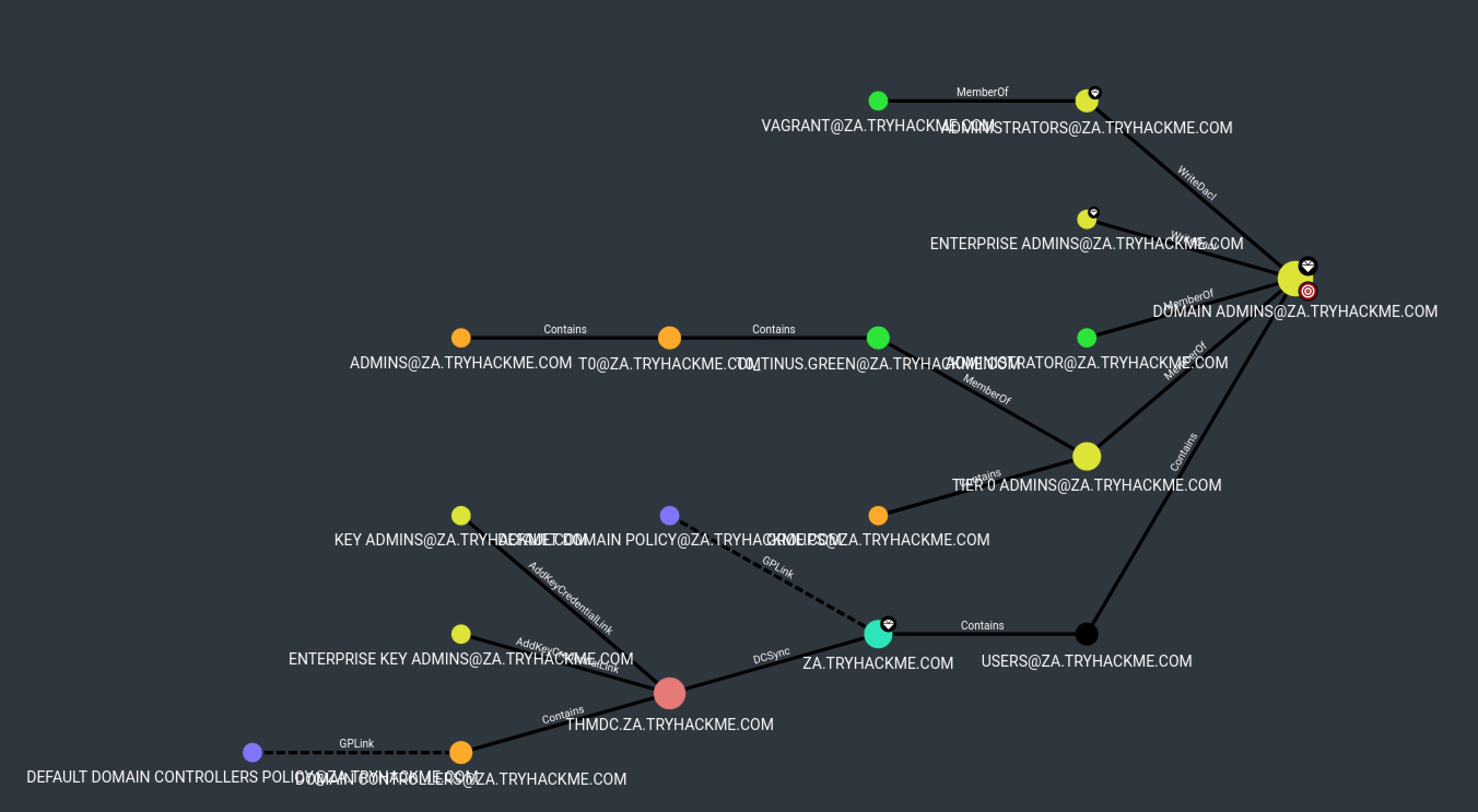
Task 6 Answers
Apart from the krbtgt account, how many other accounts are potentially kerberoastable?
4MATCH (n:User)WHERE n.hasspn=true RETURN n
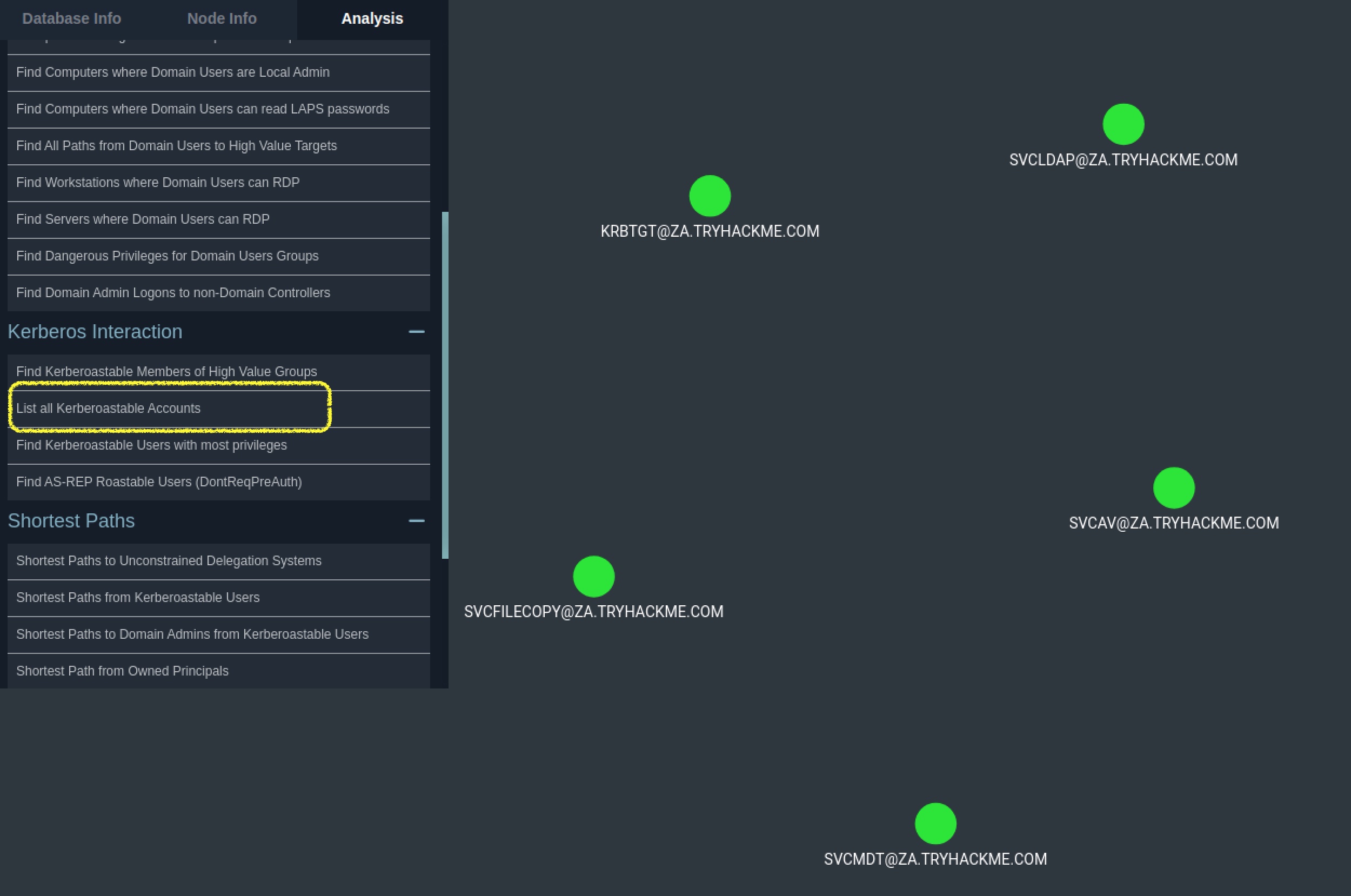
How many machines do members of the Tier 1 Admins group have administrative access to?
2MATCH p=(m:Group {objectid: "S-1-5-21-3330634377-1326264276-632209373-1105"})-[r:AdminTo]->(n:Computer) RETURN p
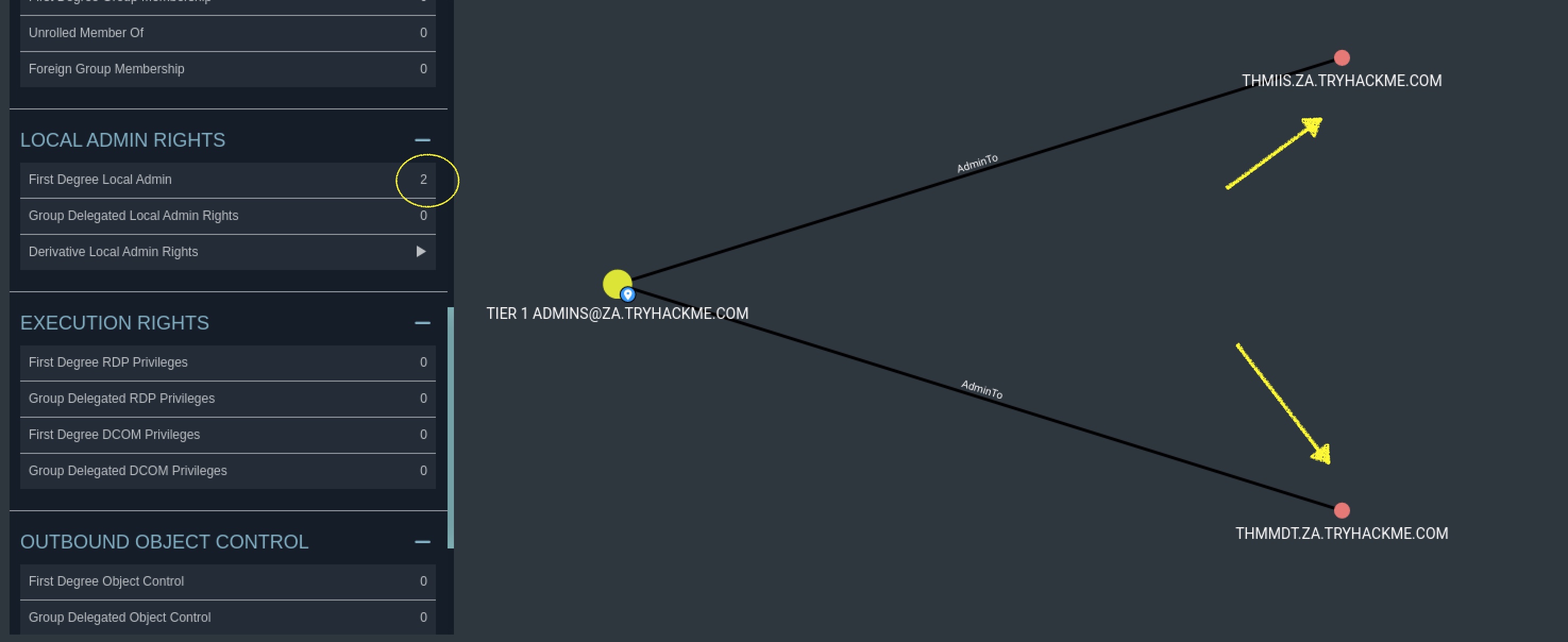
How many users are members of the Tier 2 Admins group?
15MATCH p=(n)-[b:MemberOf]->(c:Group {objectid: "S-1-5-21-3330634377-1326264276-632209373-1105"}) RETURN p
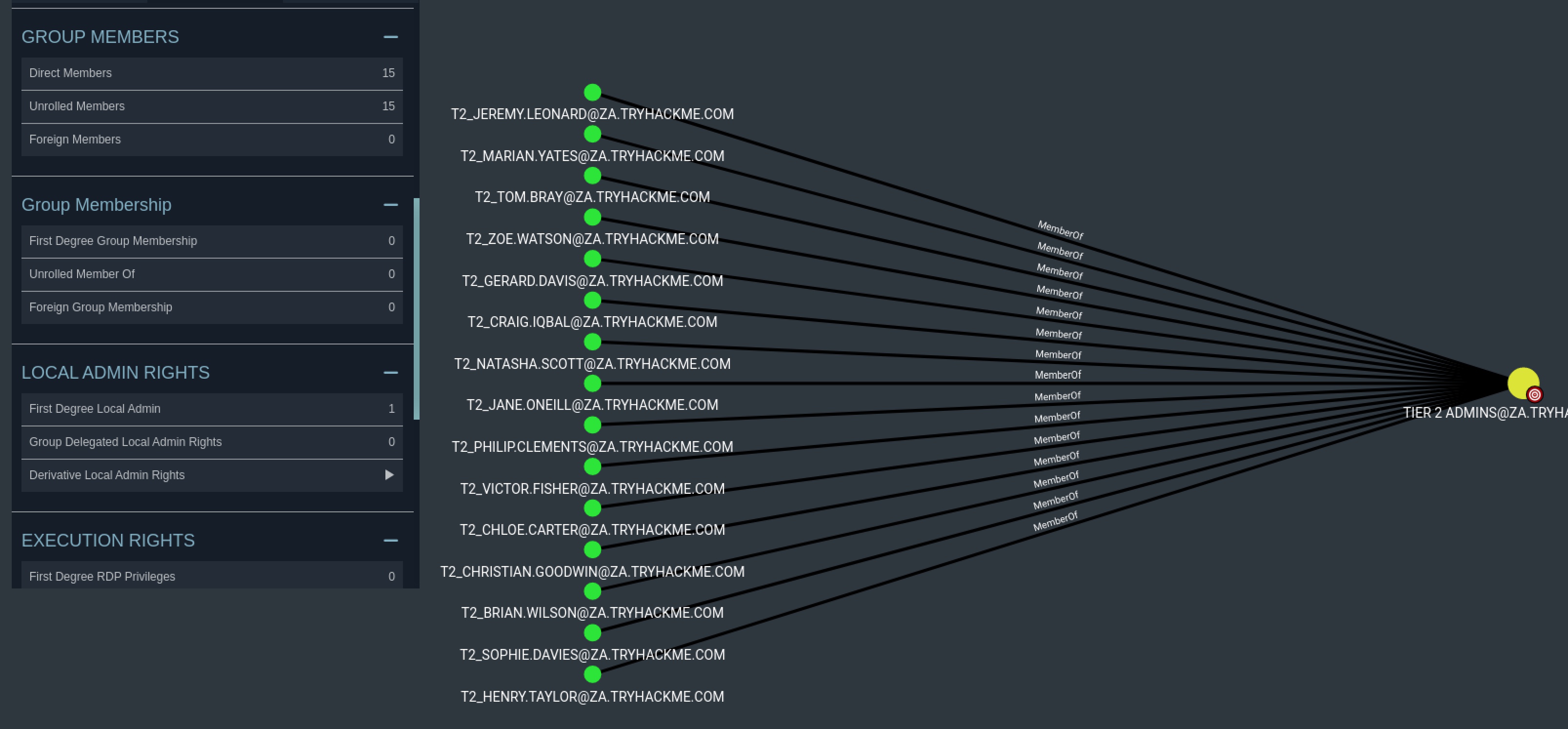
References
https://mcpmag.com/articles/2019/12/02/dns-server-search-order-with-powershell.aspx
